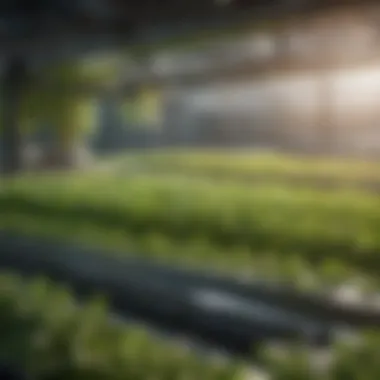NFT Hydroponics for Beginners: A Comprehensive Guide


Intro
The landscape of agriculture is shifting, and with it comes the allure of soilless cultivation methods. Among these, Nutrient Film Technique (NFT) hydroponics stands out, offering a unique approach to growing plants without traditional soil media. This guide is tailored for beginners eager to understand the fundamentals of NFT hydroponics. It will explore the methodology, provide hands-on advice and delve into the challenges and solutions associated with operating these systems.
NFT hydroponics may sound complex at first, but it essentially revolves around a few key principles. It leverages a thin film of nutrient-rich water flowing over the plant roots, which is a departure from conventional farming practices. The appeal lies not only in maximizing growth potential but also in efficient resource management, making it a favored choice for urban gardeners and large-scale agricultural setups alike.
Understanding NFT systems and their operational intricacies can significantly influence one's success in hydroponics. In this guide, readers will find practical insights, historical context, and key innovations that have driven the evolution of NFT hydroponics, all aimed at fostering a deeper understanding of this fascinating cultivation technique.
Prologue to Hydroponics
Hydroponics is a method of growing plants without soil by using nutrient-rich water solutions. This technique holds great significance in modern agriculture, particularly as sustainability becomes a pressing concern. With increasing urban populations and diminishing arable land, hydroponics presents an innovative solution that allows for efficient land use and high yield production.
In this article, we will explore NFT (Nutrient Film Technique) hydroponics in depth. Understanding hydroponic systems generally aids beginners in grasping more complex systems like NFT. It empowers them to take advantage of the benefits associated with the controlled environment of hydroponics, including quicker growth rates and reduced pest exposure.
Key benefits of hydroponics include:
- Water Efficiency: Hydroponic systems use up to 90% less water than traditional farming.
- Space Saving: Systems can be set up vertically, maximizing space in urban settings.
- Reduced Chemical Use: Targeted nutrient delivery minimizes chemical runoff and its environmental impact.
The importance of hydroponics extends to the aspect of resource management as well. With a focus on nutrient management, growers can regulate nutrient absorption and tailor their nutrient solutions. This shifts the control from nature to the grower, allowing for better predictability in crop yield.
By gaining a fundamental understanding of hydroponics and its specific techniques, such as NFT, aspiring farmers and gardening enthusiasts can engage with this modern approach to agriculture. It opens up numerous possibilities in both home gardening and commercial enterprises, all while supporting sustainability efforts in food production.
Understanding the Principles of NFT
Understanding the principles of Nutrient Film Technique (NFT) is crucial for anyone interested in hydroponics. This section explores the foundational elements that define how NFT systems function and why they are beneficial for soilless farming. Knowledge of NFT principles goes beyond mere functionality; it aids in designing efficient systems and ensures successful crop growth. Key considerations include the flow of nutrients, the role of water, and how environmental factors interact with plant health.
How NFT Works
NFT operates on a simple premise. A thin film of nutrient-rich water is continuously circulated over the roots of plants. This system allows roots to absorb the necessary nutrients while providing sufficient oxygen. The shallow channel typically used in NFT setups is designed to minimize water usage while maximizing nutrient availability.
- Water Supply: The system requires a reservoir where nutrient solutions are prepared. Pumps circulate this solution through channels where plants are positioned.
- Plant Support: Plants are placed in net pots, which hold the root system while allowing moisture and nutrients to reach them. The pots are positioned above the channel, where the nutrient film flows.
- Gravity and Flow: Unlike other hydroponic systems, NFT relies on gravity and a gentle slope to facilitate water flow. This design prevents pooling and ensures that all roots can access nutrients as needed.
The efficiency of NFT is bolstered by its recirculating nature. As the film runs down the channel, it continues back to the reservoir, where it can be reused. This process not only conserves water but also reduces the need for frequent nutrient replenishment.
"Understanding the mechanics of NFT can significantly impact growing success in hydroponics."
Importance of Nutrient Management
Nutrient management is a critical aspect of NFT hydroponics. Efficient nutrient delivery impacts plant growth, yield, and overall system sustainability. It’s essential to closely monitor and adjust nutrient levels according to the specific needs of the crops being grown.
- Nutrient Balance: Plants require a balance of macro and micronutrients. In NFT systems, the concentration of these nutrients must be regularly checked to ensure plants are receiving adequate nourishment.
- Water pH Levels: The pH level of the nutrient solution influences nutrient availability. Regular testing ensures that pH remains within an optimal range (generally between 5.5 and 6.5) for maximum uptake.
- Monitoring Conductivity: Electrical conductivity (EC) measurements provide insight into nutrient concentration in the water. Keeping track of EC will help in maintaining effective nutrient levels.
- Adjusting Nutrient Schedules: Different plants have different feeding schedules. Adjusting nutrient introductions according to growth stages can optimize health and productivity.
Effective nutrient management is the backbone of a successful NFT hydroponics system. Recognizing the signs of nutrient deficiencies or excesses allows growers to make timely adjustments.
Materials Required for NFT Hydroponics
In the realm of hydroponics, particularly when it comes to the Nutrient Film Technique (NFT), understanding the materials required is critical. Each element plays a vital role in ensuring the system operates efficiently. A well-selected combination of equipment and supplies sets the stage for a successful growing environment and maximizes plant health and yield.
Essential Equipment and Supplies
Starting with the essential equipment, having the right tools can significantly determine the effectiveness of your NFT system. Here are some key items:
- Growing Channel: This is where the plants will grow. It is usually made of PVC or another non-toxic material. Ensure the channel is sloped slightly to allow nutrient flow by gravity.
- Reservoir: The reservoir holds the nutrient solution that is later pumped into the growing channel. Proper size matters; it must accommodate the expected water and nutrient needs without frequent refills.
- Pump: A reliable water pump is necessary to provide the nutrient delivery system. Choose a pump with adequate flow rate for your specific setup.
- Tubing: Using correct tubing diameter is important for maintaining proper flow rates. Flexible tubing allows for easier installation.
- Net Pots: These hold the plants in place and allow roots to grow down into the nutrient film that flows below. Proper size ensures that your plants' roots can access the nutrients effectively.
- Air Pump and Air Stone: To keep the nutrient solution well-oxygenated, an air pump paired with air stones will help to enrich the solution with necessary oxygen.
- Nutrient Solution: This is crucial for plant health. Specific nutrients are needed throughout various growth stages.
Each piece of equipment should be carefully considered for its quality and appropriateness for the size and scale of the growing operation.
Types of Growing Mediums
While NFT systems are unique in that they often use no growing medium, some growers opt to include mediums to support the plants. Various growing mediums can provide additional stability, moisture retention, or airflow to the roots, depending on your preferences. Here are a few commonly used mediums:


- Rockwool: This is a popular option that retains moisture well and aids in aeration. It is inert, allowing for controlled nutrition.
- Clay Pellets: These are lightweight and encourage drainage. They allow air to reach the roots while retaining some moisture.
- Coconut Coir: Made from coconut husks, this medium provides good water retention and aeration. It is also an environmentally friendly option.
- Perlite: Often mixed with other mediums, perlite increases drainage and aeration. It is lightweight and allows easier root growth.
Selecting the right growing medium, when applicable, helps cater to the specific needs of your plants while using an NFT system. Remember that not all systems will require a medium, but when implemented correctly, they can enhance plant development.
"Choosing appropriate materials is the first step towards creating a productive NFT hydroponics system. Without carefully selected equipment and mediums, success may be elusive."
In summary, the materials required for NFT hydroponics are fundamental to a successful setup. Invest time in understanding each component’s role and select wisely, keeping in mind the specific plant requirements and environmental conditions.
Setting Up Your NFT Hydroponics System
Setting up an NFT hydroponics system is a crucial step for those venturing into soilless cultivation. This phase involves understanding various elements that directly affect plant growth and overall system efficiency. By properly configuring your setup, you can enable optimal water and nutrient delivery to plants. Factors like light exposure, temperature control, and air circulation also play significant roles in this regard. These factors not only promote healthier plants but also can increase yields and reduce the risk of disease.
Design Considerations
When planning your NFT hydroponics system, several design elements must be considered:
- System Layout: The physical arrangement of components should support easy access for maintenance and monitoring. Choose spaces that allow for sufficient drainage and light exposure.
- Channel Slope: A slight slope in the channels ensures nutrient flow. Generally, a slope of 1-2% is recommended to maintain movement without pooling.
- Covering Channels: To prevent algae growth, channels should be opaque. Materials like PVC or specially designed grow trays can serve this purpose effectively.
- Length of Channels: The length should not exceed 6 feet to ensure even nutrient distribution and prevent stagnation drawbacks.
- Plant Density: Select where plants will be positioned based on their growth patterns. Consider leaving enough space to avoid competition for light and nutrients.
Each of these design considerations fosters a well-structured environment conducive to a healthy plant lifecycle. Getting the design right at the onset can save time and resources in the long run.
Step-by-Step Setup Process
To establish your NFT hydroponics system effectively, follow these pragmatic steps:
- Gather Equipment: Ensure you have all needed supplies. This includes growing channels, a water reservoir, a pump, and appropriate tubing for nutrient delivery.
- Assemble the Framework: Create a stable structure for your channels. Use PVC pipes or other suitable materials and set them at the designated slope.
- Install the Water Reservoir: The reservoir, where the nutrient solution will be stored, should be placed at a lower level. This is to facilitate gravity-driven flow into the channels.
- Connect Pump and Tubing: Connect the pump to your reservoir and run the tubing to the top of the channels. Ensure all fittings are secure to prevent leaks.
- Mix Nutrient Solution: Prior to planting, prepare your nutrient mixture according to the plants' needs, usually detailed on the product label.
- Launch the System: Turn on the pump to circulate the nutrient solution, ensuring it flows evenly along the channels.
- Plant Selection and Deployment: Choose plants compatible with NFT systems, such as leafy greens or herbs. Place them in the channels once the system is operating.
- Monitor Regularly: After setting up, keep an eye on flow rates, nutrient balance, and overall plant health. Adjustments may be necessary as plants grow.
Regular monitoring is key to sustainable plant health in NFT hydroponics. Missing this step can lead to serious issues later in the cultivation process.
By following these steps, you set a solid foundation for your NFT hydroponics system. Each process is interlinked, reinforcing the importance of correct installations and adjustments in achieving optimal growth.
Selecting Appropriate Crops for NFT
Choosing the right crops for your NFT system is crucial for a successful hydroponic experience. The Nutrient Film Technique works best with specific plants that can thrive in a soilless environment. Factors such as growth habits, nutritional needs, and compatibility with NFT mechanics play significant roles in this selection process. A considerate choice not only maximizes yield but also minimizes issues that can arise in management and growth.
Best Plants for NFT Systems
When deciding on crops for NFT, some varieties have shown to perform particularly well. Leafy greens, such as lettuce, spinach, and kale, are excellent choices. They have relatively short growth cycles and require fewer nutrients, making them suitable for beginners.
- Lettuce: This is one of the most popular crops due to its fast growth and minimal space requirements.
- Spinach: It grows quickly and has a high nutrient demand, which NFT can efficiently meet.
- Kale: Known for its resilience; it can thrive in less favorable conditions compared to other crops.
Other plants that can be considered include herbs like basil, cilantro, and even fruits like strawberries.
Growth Patterns and Considerations
Each plant species has unique growth patterns that affect how they should be managed in NFT systems. Look at how fast they grow, their height, and their nutrient uptake.
- Fast-growing crops tend to yield quicker results, allowing for more harvests within a year.
- Height considerations are also critical. Taller plants might require additional support to prevent over-topping.
- Nutritional requirements vary; understanding the needs of chosen crops ensures that your nutrient solution is balanced.
It is important to monitor these patterns closely. Growth rates can help inform your watering and nutrient schedules, while spacing between plants can be adjusted based on their individual needs.
The right crop selection is the foundation of an efficient NFT system. By choosing wisely, you set yourself up for effective growth and successful harvests.
Selecting appropriate crops not only enhances the functionality of your system but also boosts your confidence as a hydroponic grower.
Operating Your NFT System
Operating an NFT system effectively is crucial for achieving optimal growth and yield from your hydroponic setup. This section delves into the primary elements that contribute to the successful functioning of Nutrient Film Technique systems. Understanding these elements enables growers to provide the right conditions for plant health, ultimately leading to a prosperous harvest.
Water and Nutrient Management
Water is the lifeblood of nutrient film technique systems. In NFT, a thin film of nutrient-rich water continuously flows over the roots of the plants. This facilitates excellent absorption of nutrients while preventing root rot that may occur when plants sit in standing water.


Key aspects of managing water and nutrients include:
- Nutrient Solution Composition: The choice of nutrients is essential. A balanced mix of macro and micronutrients should be maintained. Regularly testing the pH levels of the solution is critical. Ideally, the pH should be kept between 5.5 and 6.5.
- Flow Rate: The flow rate of the nutrient solution must be regulated to ensure the roots receive enough moisture without being submerged. A typical flow rate is 1-2 liters per hour but can vary based on factors like plant types and environmental conditions.
- Water Temperature: Ideal water temperatures range from 18°C to 22°C. Temperatures outside this range can hinder nutrient uptake.
To assure successful water and nutrient management, make a schedule for testing the solution rather than waiting until problems arise. Regular adjustments based on plant growth stage can enhance performance significantly.
"Consistent monitoring and adjustment of the nutrient solution are imperative for the success of NFT systems."
Monitoring Environmental Conditions
The environment in which an NFT system operates can greatly affect plant health. Key conditions to monitor include light, temperature, humidity, and CO2 levels.
- Light: Most plants require specific light conditions for photosynthesis. Using grow lights can ensure that plants receive adequate light if natural sunlight is insufficient. The right spectrum and intensity depend on the type of plants being cultivated.
- Temperature: Ideal temperatures generally range from 18°C to 24°C during the day, with slightly cooler conditions at night. This temperature stability promotes healthy growth.
- Humidity: High humidity can foster fungal diseases, while low humidity can cause plants to transpire too much water. Maintaining humidity levels between 40% and 70% is often recommended.
To keep track of these factors, consider investing in reliable sensors and data logging devices. Continuous monitoring not only allows for timely interventions but also helps fine-tune the growing conditions for enhanced productivity.
Common Challenges in NFT Hydroponics
Understanding the common challenges in NFT hydroponics is vital for those embarking on this method of cultivation. Success in hydroponics not only relies on proper setup but also on the ability to troubleshoot issues as they arise. Learners must recognize that even a slight error in nutrient delivery or environmental conditions can significantly affect plant health. Thus, mastering the identification and resolution of potential problems is essential for cultivating healthy crops while ensuring a productive yield.
Identifying and Resolving Issues
In NFT systems, the thin film of nutrient solution running along the roots can be sensitive to various factors. Common issues in NFT hydroponics include:
- Nutrient Imbalance: Incorrect nutrient concentrations can lead to nutrient burn or deficiencies.
- Clogged Channels: Debris or roots may obstruct nutrient flow, impacting plant growth.
- Oxidation and Root Rot: Poor oxygenation can cause roots to rot, leading to plant death.
Regular monitoring is essential. Observing plant symptoms and conducting routine checks on the nutrient solution is key to early detection.
To resolve these issues, a systematic approach is necessary. Steps to take may include:
- Testing Nutrient Levels: Utilize an EC meter to regularly check nutrient concentration.
- Clearing Obstructions: Inspect and clean channels to prevent clogging every few weeks.
- Enhancing Oxygen Supply: Employ air stones or adjust water levels to maximize root exposure to oxygen.
By addressing these concerns promptly, you can maintain a healthy environment for plant growth.
Preventive Measures for Success
To minimize the challenges faced in NFT hydroponics, preventive measures can significantly enhance your system's efficiency and productivity. Consider the following strategies:
- Regular Maintenance: Set up a routine maintenance schedule for checking nutrient solutions, cleaning systems, and monitoring plants.
- Choosing the Right Crops: Select plants that are well-suited for NFT systems, such as leafy greens, which adapt well to the shallow roots in this method.
- Investing in Quality Equipment: Ensure your pumps and channels are durable and reliable to reduce the risk of failure.
In addition, keeping a log of environmental conditions can help you notice patterns or recurring issues and make informed adjustments accordingly. Incorporate sensors to automate some monitoring processes, which can also aid in detecting problems sooner.
With a proactive mindset, you can significantly reduce potential obstacles in NFT hydroponics and focus on optimizing plant growth.
Maintenance and Care for NFT Systems
Maintenance and care are crucial aspects of successful NFT hydroponics. Proper upkeep ensures that the plants thrive, maximizing yield and maintaining system efficiency. Without regular attention, challenges like algae growth or nutrient imbalance can arise, complicating the process of growing plants in a soilless environment. Understanding the techniques for maintaining your NFT system is essential for any beginner aiming to optimize their hydroponic experience.
Routine Maintenance Tasks
Routine maintenance tasks involve regular checks and adjustments to ensure optimal conditions within your NFT system. These tasks should be integrated into your weekly activities to keep the system running smoothly. Here are some key tasks to focus on:
- Check nutrient solution levels: Regularly inspect the nutrient reservoir and replenish as needed to maintain the appropriate water levels. A drop in levels can lead to insufficient nutrient uptake.
- Monitor pH and EC levels: Use a calibrated pH and EC meter to regularly check the nutrient solution. Optimal pH levels for most crops range from 5.5 to 6.5, while Electrical Conductivity (EC) values depend on the crop type.
- Inspect the pump and tubing: Ensure that the pump operates smoothly and that no clogs exist in the tubing. Clogged pipes can disrupt the flow of nutrients to the plants. Clean them if necessary.
- Clean the system components: Algae and residue can build up in your system, potentially harming plant health. Clean the reservoir, tubing, and other components to prevent this.
Long-term Care Strategies
Long-term care strategies play an equally important role in maintaining a thriving NFT system. These strategies are designed for sustainability and optimal performance over time. Consider the following actions:
- Periodic system upgrades: As technology advances, consider integrating better equipment or automation tools for monitoring conditions and delivery of nutrients. This upgrade can lead to significant improvements in efficiency.
- Rotate crops: Practicing crop rotation helps prevent nutrient depletion and reduces pest problems. Varying your crop selections allows for a diverse nutrient intake and promotes better overall health in the system.
- Regularly review crop performance: Maintain notes on crop growth and health. This data can guide future planting decisions and adjustments in your nutrient strategies.
- Engage with community resources: Stay updated with the latest practices in hydroponics by engaging in forums like Reddit's hydroponics community. Learn from others and apply best practices to your system.


"Regular maintenance and attention to detail in NFT hydroponics can significantly enhance both growth rates and crop yields."
By focusing on routine tasks and long-term care, you position your NFT system for continued success. This proactive approach reduces complications and maximizes the benefits of hydroponic farming.
Sustainability in NFT Hydroponics
Sustainability in NFT hydroponics is vital for creating more environmentally-friendly farming practices. As the world faces numerous ecological challenges, methods like Nutrient Film Technique play a crucial role, allowing for efficient resource use in agriculture. One of the core benefits of NFT systems is their reduced water consumption compared to traditional farming methods. Water recirculation minimizes waste, making it a preferable choice for those concerned about water scarcity.
Moreover, NFT hydroponics is suited for urban settings. It enables local food production, reducing the carbon footprint associated with transporting vegetables over long distances. Urban agriculture can leverage small spaces more effectively with vertical farming setups, integrating NFT into city landscapes. There are also fewer chemical fertilizers needed in hydroponics, which leads to less runoff and lower pollution levels compared to conventional farming.
Now, it is important to consider some challenges of sustainability in NFT systems. While there is less resource input, the energy required for pumps and lights can be significant. An over-reliance on electricity can contradict the sustainable goals one aims to achieve. Therefore, incorporating renewable energy sources, such as solar power, becomes a crucial consideration.
"NFT systems not only conserve water but also promote local food production, which proves essential in urban environments."
Additionally, growers must maintain a careful balance of nutrients in the solution. This requires knowledge and monitoring to ensure plants receive optimal conditions without excess waste. Regular monitoring can lead to innovative practices that further reduce waste and improve yield.
Environmental Impacts of Hydroponics
The environmental impacts of hydroponics focus on both advantages and disadvantages of these soilless systems. One significant benefit is the reduction of land use. Traditional agriculture often requires large plots, which can lead to habitat destruction. In contrast, NFT hydroponics allows crops to be grown in smaller areas.
Hydroponics can limit the use of pesticides and herbicides. As plants are grown in controlled environments, the need for harmful chemicals diminishes. This results in cleaner produce, contributing to better human health and less environmental toxicity.
However, the energy demands of maintaining hydroponic systems should also be examined. Powering pumps, lights, and other equipment typically relies on electricity, leading to a carbon footprint. For instance, studies show hydroponic systems can have a varied impact based on energy sources used.
- Advantages of Hydroponics
- Disadvantages of Hydroponics
- Reduced land usage
- Minimal use of chemicals
- Higher crop yields in smaller areas
- High energy consumption
- Dependence on technology
In summary, NFT hydroponics presents both opportunities and challenges for environmental sustainability. While it offers innovative solutions for land and resource use, careful consideration of energy sources and impacts is essential to achieve truly sustainable practices.
Advancements in Sustainable Practices
The advancement of sustainable practices in NFT hydroponics reflects an ongoing evolution in agricultural technology. Innovative solutions are emerging to address the challenges associated with traditional and even existing hydroponic systems. One significant area of progress is the integration of renewable energy sources.
Using solar panels and wind turbines can drastically cut the energy costs associated with NFT setups. Many growers are now exploring systems designed to harness these energy sources effectively. This not only reduces the carbon footprint but also lowers operational costs in the long run.
Another advancement includes improvements in nutrient delivery systems. Precision agriculture utilizes technology to apply nutrients at optimal amounts. These systems can analyze plant needs in real-time and adjust accordingly. Such precision minimizes waste and enhances plant health by ensuring they receive exactly what they require.
"Adopting renewable energy and precision technology can elevate the sustainability of NFT hydroponic systems to new heights."
Water recycling technology has also seen significant developments. Closed-loop systems offer efficient water management, reducing overall usage while maintaining plant health. Eco-friendly filtration methods help purify the water for reuse, promoting sustainability.
Moreover, the future of NFT is also trending towards automation. Automation decreases labor costs and human error, while also implementing efficient monitoring systems. This ensures that plants receive optimal growth conditions. By reducing vulnerability to mistakes, overall resource management can be vastly improved.
These advancements, along with key innovations in NFT hydroponics, point towards a sustainable future in agriculture. The technologies and practices evolving in this field promise to create a more efficient and eco-friendly agricultural practice, ensuring crops can be produced without compromising environmental integrity.
Future Prospects of NFT Hydroponics
The future of Nutrient Film Technique (NFT) hydroponics holds promising developments that are pivotal for both urban agriculture and sustainable farming practices. As interest in hydroponics grows, particularly in densely populated areas, leveraging NFT systems can significantly enhance food security while utilizing less land and resources. Understanding the trajectory of this technology is essential because it lays the groundwork for innovation in cultivation methods and resource management.
Trends in Hydroponic Technologies
Current advancements in hydroponic technologies reflect an increasing integration with modern tools. For instance, automation and smart technology play a crucial role. Sensors and IoT devices can monitor plants' needs, making it easier to manage water and nutrient levels. Furthermore, the rise of aquaponics, where fish are integrated into hydroponic systems, shows how NFT techniques can evolve. These developments not only reduce waste but also create a synergistic environment for plant and fish growth.
Another trend worth noting is the enhancement of nutrient solutions designed for NFT. With research focusing on optimizing these solutions, growers can achieve better yields and crop quality. This focus on scientific advancements ensures that NFT remains relevant and competitive amid other agricultural practices.
NFT's Role in Modern Agriculture
NFT's role in modern agriculture is indispensable as society faces challenges like climate change and population growth. Traditional farming methods often require extensive land and water, which are increasingly scarce. NFT hydroponics, with its efficient nutrient delivery and reduced water usage, presents a practical solution.
The adoption of NFT systems in urban farming also exemplifies its potential. Here, farms can be established in non-traditional spaces like rooftops and basements, providing fresh produce close to consumers. This local production reduces transportation costs and carbon footprints.
Moreover, as global awareness of sustainable practices rises, NFT's contribution to regenerative agriculture is noteworthy. It promotes a closed-loop system where waste is minimized, and resources are recycled.
"In the coming years, the integration of NFT systems in agriculture will likely expand, driven by the need for sustainable solutions and food security."



